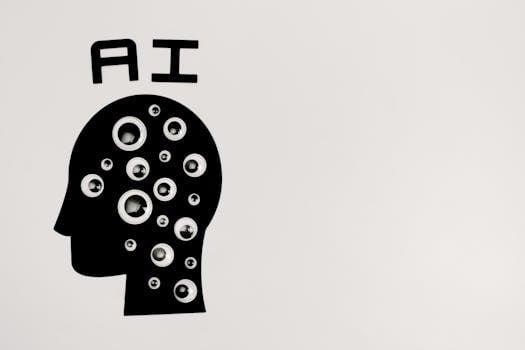
Artificial intelligence (AI) and machine learning (ML) are transforming software development‚ offering new tools and approaches. These technologies are becoming essential for modern coders‚ with practical applications and vast potential. This introduction outlines the importance of AI and ML within the coding world. The integration of these concepts helps to create innovative solutions.
The Growing Importance of AI/ML in Software Development
The integration of Artificial Intelligence (AI) and Machine Learning (ML) is rapidly reshaping the software development landscape‚ marking a significant shift in how applications are built and deployed. AI-powered tools are no longer a futuristic concept but a present-day reality‚ enhancing developer productivity and enabling creation of smarter software. From automating code generation to improving testing and debugging processes‚ AI/ML is becoming indispensable. The increasing complexity of software demands more efficient methods‚ and AI/ML provides the means to achieve this. Furthermore‚ AI/ML drives innovative features in applications‚ providing personalized experiences and intelligent automation. The need for coders to grasp these technologies is becoming paramount for success in a rapidly evolving industry. Understanding and utilizing AI/ML are no longer optional but are core requirements for effective software development. As the demand for smarter and more efficient software continues to grow‚ the importance of AI/ML will be even more emphasized in the software development field.

Core Concepts of AI and ML
Understanding AI and ML involves exploring fundamental concepts. Machine learning‚ a subset of AI‚ uses algorithms to learn from data. These core ideas are vital for coders entering this field; Deep learning is also key.
Machine Learning Fundamentals
Machine learning (ML) empowers computers to learn from data‚ making predictions or decisions without explicit programming. This involves diverse methods such as supervised‚ unsupervised‚ semi-supervised‚ and reinforcement learning. Supervised learning utilizes labeled data to train models‚ while unsupervised learning explores patterns in unlabeled data. Semi-supervised learning combines both labeled and unlabeled data. Reinforcement learning involves agents learning through trial and error‚ receiving feedback in the form of rewards or penalties. Key concepts also include data preprocessing‚ which ensures data quality and suitability‚ and model deployment‚ which involves putting the trained model into production. Understanding these fundamentals is essential for coders venturing into AI‚ enabling them to build effective ML solutions. Further‚ practical experience with ML algorithms in various fields also proves valuable. This knowledge provides a solid foundation for more advanced AI/ML topics.
Deep Learning Basics
Deep learning (DL)‚ a subset of machine learning‚ utilizes artificial neural networks with multiple layers to extract complex patterns from data. This approach excels in tasks involving image recognition‚ natural language processing‚ and speech recognition. Core concepts include neural network architectures‚ activation functions‚ and optimization algorithms. Neural networks are modeled after the human brain‚ with interconnected nodes or neurons. Activation functions introduce non-linearity‚ allowing networks to learn complex relationships. Optimization algorithms‚ like gradient descent‚ refine the network’s parameters during training. Deep learning models often require significant computational resources and large datasets for effective training. Understanding these foundational principles is crucial for coders aiming to leverage the power of deep learning in their projects. Practical experience with frameworks like TensorFlow and PyTorch further deepens one’s understanding of DL.

Practical Applications for Coders
AI and ML offer practical solutions for coders‚ including AI-powered coding assistants and ML in software testing and debugging. These tools improve efficiency‚ automate tasks‚ and enhance code quality significantly.
AI-Powered Coding Assistants
AI-powered coding assistants are revolutionizing how software is developed by providing real-time suggestions‚ code completion‚ and error detection. These tools‚ such as GitHub Copilot‚ leverage machine learning to analyze code patterns‚ offering contextual recommendations that accelerate development processes. These intelligent assistants not only help in writing code faster but also ensure better code quality by identifying potential issues. They can generate code snippets‚ suggest function names‚ and even write entire blocks of code based on comments or specifications. The integration of AI into coding workflows is leading to increased productivity and reduced development time. These assistants also aid in learning new languages and frameworks‚ as they provide examples and suggestions‚ thereby democratizing access to complex coding concepts. As AI continues to evolve‚ we can expect coding assistants to become even more sophisticated and integrated into every aspect of software development‚ fundamentally changing the way coders work. The rise of AI-driven coding tools marks a major shift in how coders approach their tasks.
ML in Software Testing and Debugging
Machine learning is significantly enhancing software testing and debugging by automating many traditionally manual processes. ML algorithms can analyze vast amounts of code and test data to identify patterns and predict potential bugs before they surface. This proactive approach to testing saves time and resources by addressing issues early in the development cycle. ML models can also generate test cases automatically‚ increasing test coverage and ensuring more thorough software validation. In debugging‚ ML helps by analyzing error logs and identifying root causes‚ which drastically speeds up the debugging process. These tools can even detect anomalies in software behavior‚ which human testers might miss. The use of machine learning reduces human error and improves the reliability of the software being developed. The integration of ML into testing and debugging workflows also contributes to the creation of more robust and stable software. Ultimately‚ ML’s impact on software quality is profound‚ leading to faster development cycles and lower costs associated with bug fixing.

Essential Tools and Frameworks
For AI and ML development‚ coders utilize specific tools. Popular programming languages like Python‚ along with frameworks such as TensorFlow‚ PyTorch‚ and scikit-learn‚ are essential components. These tools streamline the creation of AI applications.
Popular Programming Languages for AI/ML
Python stands out as the most popular language for machine learning‚ boasting extensive libraries and a supportive community. Its clear syntax and versatility make it ideal for both beginners and experienced developers. R is also a significant language‚ particularly favored in statistical computing and data analysis‚ offering powerful tools for deep learning and reinforcement learning. Java‚ with its robustness and platform independence‚ remains relevant in enterprise-level AI applications‚ while Julia provides high performance for scientific and numerical computing. These languages offer different strengths‚ catering to various aspects of AI and machine learning development. The choice often depends on project requirements and developer preferences. From building complex neural networks to performing data manipulation‚ these languages form the cornerstone of AI/ML coding. Furthermore‚ understanding these different languages can help coders take advantage of the best tools for their specific task. The landscape is varied with options suitable for a range of applications‚ from rapid prototyping to large scale deployments.
Key Libraries and Frameworks (TensorFlow‚ PyTorch‚ scikit-learn)
TensorFlow‚ a powerful open-source library‚ is widely used for numerical computation and large-scale machine learning. Its flexibility and comprehensive ecosystem make it a favorite for developing complex models. PyTorch‚ another leading framework‚ is known for its dynamic computational graphs and ease of use‚ especially in research settings. Scikit-learn‚ on the other hand‚ provides a suite of simple and efficient tools for predictive data analysis‚ including classification‚ regression‚ and clustering algorithms. These libraries are crucial for building machine learning projects‚ providing pre-built functions and utilities. They enable coders to focus on problem-solving rather than low-level implementation details. The combination of these frameworks provides a rich environment for both research and practical application. Mastery of these tools is essential for any coder venturing into the world of AI/ML. These libraries simplify the complex tasks required to implement machine learning solutions. They also help speed up development and collaboration in projects.

Learning Resources for Coders
Numerous online courses and bootcamps provide structured learning paths for AI/ML. Free resources‚ tutorials‚ and documentation offer additional support. These learning materials cater to different skill levels.
Online Courses and Bootcamps
Several online platforms offer comprehensive courses and bootcamps tailored for coders seeking to learn AI and ML. These resources provide structured learning paths‚ often combining theoretical concepts with practical coding exercises. For instance‚ MLOps Zoomcamp is a great course on MLOps that focuses on deployment. Practical Deep Learning is designed for those with existing coding experience. These courses usually cover a range of topics‚ from fundamental machine learning algorithms to advanced deep learning techniques. Many bootcamps provide hands-on projects‚ allowing coders to apply their knowledge. Led by expert data scientists‚ courses delve into areas like reinforcement learning and natural language processing (NLP)‚ providing both resources and tasks for skill application. These courses may also incorporate popular languages such as Python and R‚ with code templates for easy implementation. They offer a structured and guided learning experience.
Free Resources and Tutorials
Numerous free resources and tutorials are available for coders eager to explore AI and ML. Many platforms provide open-access materials‚ enabling self-paced learning without financial barriers. The “AI Canon” offers a curated list of resources‚ while the “Coding Train” YouTube channel is a treasure trove for learning how to code with practical examples. W3Schools offers tutorials‚ exercises‚ and references in many coding languages for those looking to enhance their coding skills. Machine Learning Crash Course has been refreshed with recent advances in AI‚ and has a stronger focus on practical applications. These platforms often include documentation‚ code examples‚ and community forums. These resources cover a wide range of topics from basic concepts to complex algorithms‚ suitable for various skill levels. Learning platforms also divide knowledge into smaller parts‚ making the process smoother and more accessible. These are very useful to learn the best methods and practices.